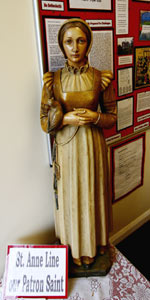Our School
There are no strangers here, just friends we have yet to meet.
St Anne Line Junior School was opened in 1964 to serve the Catholic families living in the West side of Basildon and those living in Wickford & Laindon. Over this time, there have been three Head Teachers, Mr Fox, Mr Larrett and now Miss Watson.
It is a voluntary aided school. The upkeep is partly paid by the governors and part by Essex County Council.
The school has eight teaching areas arranged in three groups around an attractive quadrangle. There is a large playing field located in the school grounds and the Church of the Most Holy Trinity is only a short walk from the school.
The Story of St Anne Line School
 Anne Line was born at Dunmow in Essex, probably in the late 1560’s. There is a tradition that the Clock House on Thaxted Road, Dunmow, was her home. In her youth Anne was a Calvinist, with a strict Protestant upbringing. However, Anne & her brother became converts to the Catholic faith and by doing so they were thrown out of their family home by their father. At the time, practicing Catholicism was a very dangerous thing to do.
Anne Line was born at Dunmow in Essex, probably in the late 1560’s. There is a tradition that the Clock House on Thaxted Road, Dunmow, was her home. In her youth Anne was a Calvinist, with a strict Protestant upbringing. However, Anne & her brother became converts to the Catholic faith and by doing so they were thrown out of their family home by their father. At the time, practicing Catholicism was a very dangerous thing to do.
Anne married a staunch Catholic, Roger Line, who too lost his inheritance by keeping the faith. The Lines were originally from Hampshire. The date of Anne’s marriage in unclear but her husband was arrested in 1585 for assisting Mass and was banished to Belgium where he died in 1594.
Upon his death, Anne became the housekeeper to a Jesuit Priest, Fr. Gerard, who set up a secret house in London. Anyone who willingly aided or maintained Jesuits or priests faced the death penalty. Fr. Gerard called Anne a very good and prudent widowed lady … full of kindness with a soul in great peace. It appears that Anne was often ill and life was extremely poor. However, she was devoted to the Catholic faith and the priesthood. As part of her ‘disguise’ Anne took the name Mrs Martha and was arrested in 1601 under this name.
It seems Anne allowed an unusually large number of Catholics to hear Mass on the Feast of the Purification. Some neighbours noted the crowd and the constables were at the house at once. The priest, Fr. Francis Page, managed to escape, but Anne was arrested on February 2nd 1601. She was taken to Newgate Prison & tried before Lord Chief Justice Popham, a bitter enemy of Catholicism who condemned her to death on February 26th 1601.
The next day she was taken from Newgate to Tyburn. Along the journey she was urged to convert back to Protestantism to save herself. She refused. When she reached the gallows she kissed them, knelt for her private prayers and threw money & a handkerchief to the crowd. She made the sign of the cross & then walked to her death – hung at Tyburn. Her body was thrown into a common grave with the others killed that day.
But is seems her body was ‘rescued’ by the Countess of Arundel who wrote of her being constant and courageous in the defence of the faith. The Countess brought her body to her own house where it was kept with reverence ’till it could be buried by members of the Catholic community.
 The School Badge
The School Badge
Anne’s motto IN MAGNA CONSTANTIA reflects the view of the Countess of Arundel whilst the key reflects her role as housekeeper. The palm represents her martyrdom for the faith.
She is remembered at our school on the 2nd February (the date of her arrest) each year.
